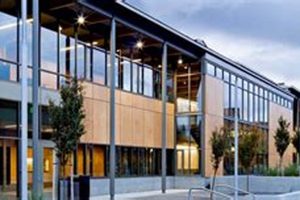High school students participating in structured, high-intensity functional fitness programs experience a blend of weightlifting, metabolic conditioning, and gymnastics movements. A typical session might involve exercises like squats, pull-ups, Olympic lifts, running, and rowing, often performed in timed workouts or against other participants. This approach emphasizes varied functional movements executed at high intensity to improve overall fitness.
Such programs offer numerous potential advantages for adolescents. Physical benefits include increased strength, endurance, and flexibility, contributing to improved cardiovascular health and reduced risk of obesity. Furthermore, the challenging nature of these workouts can foster mental resilience, discipline, and teamwork. While relatively recent in secondary education, this type of fitness training builds upon established principles of physical education and athletic development, adapting them for a new generation.
This discussion will further explore the integration of these programs in secondary education, addressing key considerations such as program design, safety protocols, coaching qualifications, and the potential impact on student health and athletic performance.
Tips for Implementing Functional Fitness Programs in High Schools
Successful integration of high-intensity functional fitness requires careful planning and execution. The following tips offer guidance for establishing safe and effective programs within a secondary school setting.
Tip 1: Prioritize Qualified Coaching: Instructors should possess recognized certifications in functional fitness training and demonstrate experience working with adolescent athletes. Expertise in proper movement mechanics, exercise modifications, and injury prevention is crucial.
Tip 2: Implement Scalable Workouts: Program design must accommodate varying fitness levels. Workouts should be adaptable, allowing modifications in weight, intensity, and movement complexity to suit individual student capabilities.
Tip 3: Emphasize Proper Technique: Correct form should always take precedence over speed or weight. Coaches must provide thorough instruction and consistent feedback to ensure students perform exercises safely and effectively.
Tip 4: Create a Supportive Environment: Foster a positive and encouraging atmosphere where students feel comfortable challenging themselves without fear of judgment. Teamwork and mutual support can enhance motivation and engagement.
Tip 5: Integrate with Existing Curriculum: Align functional fitness training with broader health and physical education goals. Connect the program to concepts of overall wellness, nutrition, and lifelong fitness habits.
Tip 6: Monitor Progress and Provide Feedback: Regularly assess student progress using objective measures such as strength gains, improved endurance, and skill development. Provide individualized feedback to motivate and guide improvement.
Tip 7: Ensure Adequate Equipment and Facilities: Provide access to appropriate training equipment, including barbells, kettlebells, pull-up bars, and ample space for safe movement. Maintain equipment in good working order and ensure a safe training environment.
By adhering to these guidelines, schools can create robust functional fitness programs that contribute to student health, athletic development, and overall well-being. Proper implementation ensures that students gain maximum benefit while minimizing risks.
These considerations provide a foundation for understanding the complexities and potential of functional fitness programs in high schools. Further exploration of these topics will offer a comprehensive perspective on best practices and future directions.
1. Qualified Coaching
The efficacy and safety of CrossFit-style training in high schools hinges significantly on the presence of qualified coaching. Expert guidance is essential not only for maximizing athletic development but also, and more importantly, for mitigating the inherent risks associated with high-intensity exercise during adolescence. This involves a multifaceted approach encompassing technical proficiency, pedagogical skill, and a deep understanding of adolescent physiology and development.
- Movement Expertise:
Coaches must possess a comprehensive understanding of functional movement patterns and the biomechanics underlying CrossFit exercises. This includes proficiency in demonstrating and teaching Olympic lifts, gymnastic movements, and other complex exercises commonly incorporated into these programs. In-depth knowledge allows for precise cueing, correction of faulty movement patterns, and the implementation of appropriate modifications to prevent injuries. A qualified coach can differentiate between safe adaptation and potentially harmful deviations from proper form, ensuring students train effectively and safely.
- Program Design and Scalability:
Qualified coaches are adept at designing workouts that are both challenging and adaptable to varying fitness levels within a high school population. This requires an understanding of how to scale workouts appropriately, modifying weight, intensity, and movement complexity to accommodate individual student capabilities and pre-existing conditions. Effective program design also considers the long-term athletic development of adolescents, emphasizing gradual progression and avoiding overtraining.
- Risk Management and Injury Prevention:
A significant aspect of qualified coaching involves proactive risk management and injury prevention strategies. This includes thorough warm-up protocols, proper cool-down routines, and the ability to recognize early signs of overexertion or potential injury. Coaches should be equipped to provide immediate and appropriate responses to injuries and possess the knowledge to refer students to medical professionals when necessary. An emphasis on safe training practices fosters a culture of injury prevention within the program.
- Creating a Positive Learning Environment:
Beyond technical expertise, qualified coaches understand the importance of creating a positive and supportive training environment. This includes fostering a culture of encouragement, respect, and inclusivity. Adolescents, in particular, thrive in environments where they feel comfortable challenging themselves without fear of judgment. A positive learning environment promotes adherence to the program, encourages teamwork, and enhances overall student well-being.
These facets of qualified coaching are integral to the successful implementation of CrossFit-style training in high schools. The combination of technical proficiency, pedagogical skill, and a commitment to student well-being ensures a safe and effective training environment that promotes both physical and mental development. Ultimately, the quality of coaching directly impacts the overall success and sustainability of these programs within the secondary school context.
2. Scalable Workouts
Scalability represents a cornerstone of effective CrossFit-style programming within the high school setting. Given the wide range of physical abilities and developmental stages present in adolescent populations, the ability to modify workout intensity and complexity is crucial for both safety and efficacy. Scalable workouts allow all students to participate and benefit from the program, regardless of their starting fitness level.
- Individualized Adaptation:
Workout scalability allows for personalized adaptation based on individual student needs and capabilities. This might involve adjusting the weight lifted, modifying movement standards, or reducing the duration or number of repetitions. For instance, a beginner might perform box squats while a more advanced student executes full squats. This individualized approach ensures that all students are appropriately challenged while minimizing the risk of injury.
- Progressive Overload:
Scalability facilitates progressive overload, a fundamental principle of strength and conditioning. As students gain strength and proficiency, workouts can be progressively scaled to maintain an appropriate level of challenge. This might involve increasing the weight lifted, adding more complex movements, or increasing the workout volume. Progressive overload ensures continuous improvement and prevents plateaus.
- Accommodating Diverse Needs:
High school student populations often include individuals with pre-existing injuries or physical limitations. Scalability allows coaches to modify workouts to accommodate these diverse needs. A student with a knee injury, for example, might perform alternative exercises that do not exacerbate their condition. This inclusivity ensures that all students can participate and benefit, regardless of their physical limitations.
- Promoting Engagement and Motivation:
Scalable workouts contribute to a positive and encouraging training environment. By ensuring that all students are appropriately challenged, scalability fosters a sense of accomplishment and promotes continued engagement. Students are more likely to remain motivated when they feel capable and successful, regardless of their current fitness level.
The ability to scale workouts effectively is essential for maximizing the benefits and minimizing the risks of CrossFit-style training in high schools. By enabling individualized adaptation, progressive overload, and inclusivity, scalability ensures that these programs contribute positively to the physical and mental development of all participating students, fostering a lifelong appreciation for fitness.
3. Proper Technique
Proper technique stands as a paramount concern within CrossFit programs implemented in high schools. The physically demanding nature of this training modality necessitates meticulous attention to movement mechanics, particularly during adolescence, a period of rapid growth and development. Correct execution of exercises not only optimizes performance but also significantly reduces the risk of injury, promoting long-term athletic well-being.
- Injury Prevention:
Adherence to proper technique forms the first line of defense against injuries. Correct biomechanics distribute loads efficiently across joints and muscles, minimizing strain and reducing the likelihood of overuse injuries or acute trauma. For example, maintaining a neutral spine during deadlifts and squats protects the lumbar region, while proper shoulder positioning during overhead presses safeguards the rotator cuff. In the context of high school CrossFit, where skeletal maturity is not yet complete, correct technique becomes even more critical for protecting developing musculoskeletal structures.
- Foundational Movement Proficiency:
CrossFit incorporates a wide range of functional movements, many of which serve as foundational building blocks for more complex athletic skills. Mastering proper technique in fundamental movements, such as squats, presses, and pulls, establishes a solid base for future athletic development. Consistent reinforcement of correct movement patterns in high school cultivates kinesthetic awareness and neuromuscular efficiency, translating to improved performance across various sports and physical activities.
- Performance Optimization:
Beyond injury prevention, proper technique directly influences performance outcomes. Efficient movement patterns maximize power output and minimize wasted energy, allowing athletes to lift heavier loads, move faster, and perform more repetitions. In high school CrossFit, where competitive elements often exist, proper technique becomes a key determinant of success. Moreover, optimizing movement efficiency carries over to other athletic pursuits, enhancing overall athleticism.
- Developing Lifelong Movement Habits:
Instilling proper technique in high school athletes establishes positive movement habits that extend beyond the immediate training environment. Consistent reinforcement of correct form promotes a deeper understanding of body mechanics and fosters an appreciation for mindful movement. These ingrained habits contribute to lifelong physical well-being, reducing the risk of injury and promoting healthy aging. High school represents a critical window for shaping these habits, laying the groundwork for a lifetime of physical activity.
Proper technique represents a non-negotiable element of safe and effective CrossFit programming in high schools. Its importance extends beyond immediate performance gains, encompassing injury prevention, foundational movement proficiency, and the development of lifelong healthy movement patterns. Prioritizing proper technique ensures that high school athletes not only maximize their current physical potential but also establish a foundation for long-term athletic well-being.
4. Supportive Environment
A supportive environment plays a crucial role in the successful implementation of CrossFit-style training within the high school context. The demanding physical and mental nature of this training modality necessitates an environment that fosters positivity, inclusivity, and mutual respect. This supportive atmosphere contributes significantly to student well-being, program adherence, and overall athletic development. A positive training environment can mitigate the potential for negative psychological pressures associated with high-intensity exercise, particularly during adolescence.
Several factors contribute to cultivating a supportive training environment. Coaches play a pivotal role in establishing clear expectations regarding respectful interactions and positive reinforcement. Encouraging peer-to-peer support and teamwork further strengthens the sense of community within the program. Celebrating individual achievements, regardless of fitness level, fosters a sense of belonging and shared progress. For example, acknowledging a student’s improved form or increased weight lifted can significantly boost their confidence and motivation. Similarly, celebrating team accomplishments during workouts can strengthen bonds and create a sense of shared purpose. Open communication between coaches, students, and parents also contributes to a supportive environment, ensuring that concerns are addressed promptly and constructively. Addressing instances of negativity or unhealthy competition directly and swiftly helps maintain a positive and inclusive atmosphere.
The benefits of a supportive environment extend beyond improved morale and increased enjoyment of the program. This positive atmosphere fosters resilience, mental toughness, and a growth mindset, qualities that contribute not only to athletic success but also to overall personal development. Students who feel supported and encouraged are more likely to embrace challenges, persevere through setbacks, and achieve their full potential. Furthermore, a supportive environment promotes a positive association with physical activity, increasing the likelihood of continued engagement in fitness throughout life. Creating and maintaining this type of environment requires ongoing effort and attention from coaches, school administrators, and the students themselves. However, the positive impact on student well-being and long-term athletic development makes it an essential component of successful high school CrossFit programs.
5. Curriculum Integration
Effective integration of CrossFit-style training into the high school curriculum extends beyond standalone physical education classes. Connecting these programs with broader academic subjects enhances educational value and reinforces key concepts related to health, fitness, and overall well-being. This interdisciplinary approach provides students with a more holistic understanding of the benefits of functional fitness and its relevance to various aspects of their lives.
- Health and Wellness Education:
CrossFit’s emphasis on functional movement and overall fitness aligns seamlessly with health education curricula. Integrating practical applications of exercise physiology, nutrition, and injury prevention reinforces classroom learning and provides students with tangible examples of healthy lifestyle choices. Analyzing workout data, such as heart rate and recovery metrics, can further enhance understanding of physiological responses to exercise. This connection strengthens the practical application of health concepts.
- Science Curriculum:
CrossFit provides a real-world laboratory for exploring scientific principles. Analyzing movement biomechanics, energy systems, and the physiological adaptations to exercise connects theoretical concepts from physics and biology to practical experience. Students can track their progress in strength and conditioning, applying scientific methodologies to analyze data and draw conclusions about training effectiveness. This practical application of scientific principles enhances understanding and engagement.
- Mathematics Integration:
Calculating workout repetitions, sets, weights, and percentages offers opportunities to apply mathematical concepts in a practical context. Students can track their progress, analyze data trends, and use mathematical formulas to calculate target heart rates or determine optimal training loads. This integration reinforces mathematical skills and demonstrates their real-world applicability.
- Character Development and Teamwork:
CrossFit’s emphasis on teamwork, discipline, and resilience provides valuable opportunities for character development. The challenging nature of workouts fosters perseverance and mental toughness. Collaborative exercises encourage teamwork and communication skills. Integrating these aspects into the curriculum reinforces the importance of these qualities for success both inside and outside the classroom. This integration contributes to holistic student development.
Integrating CrossFit-style training across the curriculum enhances the educational value of these programs. Connecting physical activity with academic subjects provides students with a deeper understanding of health, fitness, and their own physical capabilities. This interdisciplinary approach promotes a holistic educational experience, fostering lifelong healthy habits and a comprehensive understanding of the science and practice of fitness.
6. Progress Monitoring
Progress monitoring forms an integral component of successful CrossFit-style training programs in high schools. Systematic tracking of student performance provides valuable insights into program effectiveness, individual student development, and overall program adjustments needed for continuous improvement. Monitoring progress serves not only as a motivational tool for students but also as a critical feedback mechanism for coaches, enabling data-driven decision-making regarding program design and individual student needs.
Several methods contribute to effective progress monitoring. Regular assessment of baseline fitness levels, using metrics such as strength, endurance, and body composition, establishes a starting point against which to measure future gains. Subsequent assessments track changes in these metrics, providing quantifiable data on individual student improvement. For example, tracking the weight lifted in key exercises like squats or clean and jerks demonstrates strength gains over time. Similarly, monitoring performance in benchmark workouts, such as timed runs or maximum repetitions of specific exercises, reveals improvements in endurance and overall fitness. Coaches can also utilize qualitative data, such as observations of improved movement technique and increased student engagement, to provide a more comprehensive picture of individual progress. Regular feedback, based on this collected data, helps students understand their strengths and weaknesses, fostering a growth mindset and promoting continuous improvement.
Effective progress monitoring allows for data-driven program adjustments. Analyzing trends in student performance highlights areas where program modifications might be necessary. For example, if a significant portion of students struggle with a particular movement, it may indicate a need for additional coaching or modifications to the training program. Similarly, tracking injury rates can reveal potential weaknesses in program design or warm-up protocols. This iterative process of data collection, analysis, and program adjustment ensures that the CrossFit program remains safe, effective, and tailored to the specific needs of the student population. Furthermore, progress monitoring contributes to program accountability and provides tangible evidence of program effectiveness to school administrators and parents.
Frequently Asked Questions
This section addresses common queries regarding the implementation and benefits of CrossFit-style training in high schools.
Question 1: Is CrossFit safe for high school students?
Safety is paramount. Properly implemented programs, emphasizing qualified coaching, scalable workouts, and meticulous attention to technique, mitigate risks and prioritize student well-being. These programs focus on developing fundamental movement skills and building a foundation for long-term athletic development.
Question 2: How does CrossFit benefit high school athletes?
Potential benefits include enhanced strength, power, endurance, and flexibility, translating to improved athletic performance across various sports. Furthermore, these programs can foster mental resilience, discipline, and teamwork.
Question 3: What qualifications should coaches possess?
Coaches should hold recognized certifications in functional fitness training and demonstrate experience working with adolescent athletes. Expertise in proper movement mechanics, exercise modifications, and injury prevention is essential.
Question 4: How are workouts adapted for different fitness levels?
Scalability is key. Workouts are adapted by modifying weight, intensity, and movement complexity to accommodate individual student capabilities and ensure appropriate challenge while minimizing risk.
Question 5: How does CrossFit integrate with existing athletic programs?
These programs can complement existing athletic programs by enhancing overall fitness and developing foundational movement skills applicable to various sports. Collaboration between strength and conditioning coaches and sport-specific coaches ensures a unified approach to athletic development.
Question 6: How can parents support student participation?
Parental support plays a vital role. Open communication with coaches, encouragement of proper nutrition and recovery practices, and a focus on long-term athletic development rather than immediate results contribute to a positive and successful experience for students.
Addressing these common concerns provides a clearer understanding of the potential benefits and considerations surrounding CrossFit in high schools. Careful planning and implementation are essential for maximizing positive outcomes.
Further exploration of specific program components and implementation strategies will provide a comprehensive understanding of best practices.
CrossFit in High Schools
This exploration of CrossFit in high schools has highlighted the potential benefits and critical considerations surrounding its implementation. From qualified coaching and scalable workouts to proper technique and a supportive environment, each element plays a crucial role in ensuring program effectiveness and student safety. Curriculum integration and progress monitoring further enhance the value and accountability of these programs. The potential for CrossFit methodologies to contribute to improved athletic performance, enhanced overall fitness, and the development of lifelong healthy habits warrants careful consideration by educators and administrators.
The future of CrossFit in high schools hinges on responsible implementation, ongoing evaluation, and a commitment to student well-being. By prioritizing safety, scalability, and qualified instruction, secondary institutions can harness the potential of functional fitness to positively impact student health and athletic development for years to come. Continued research and open dialogue within the educational community will further refine best practices and ensure that these programs contribute meaningfully to the holistic development of young athletes.







